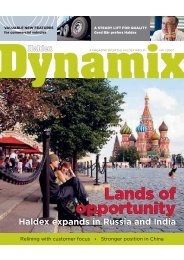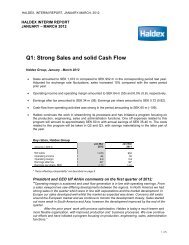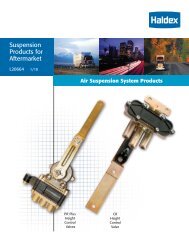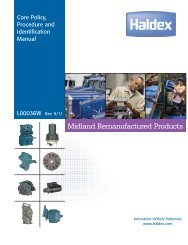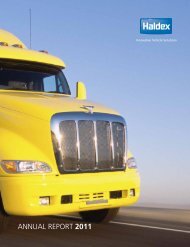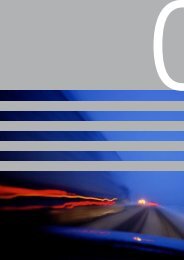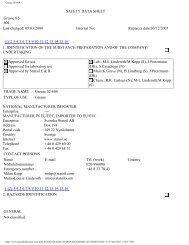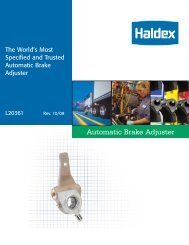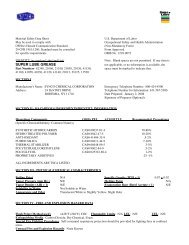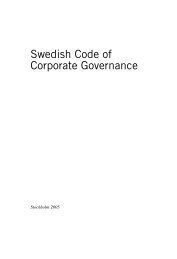Create successful ePaper yourself
Turn your PDF publications into a flip-book with our unique Google optimized e-Paper software.
e adjudged as effective hedging are recognized in<br />
profit and loss as a financial item. at the close of<br />
<strong>2011</strong>, the value of the Group’s net assets, meaning<br />
the difference between capital employed and net<br />
indebtedness, corresponded to SeK 1,336 m (2,351)<br />
and was represented by the following currencies:<br />
SeK m <strong>2011</strong> 2010<br />
SeK 502 392<br />
uSd 310 851<br />
euR 154 156<br />
GBp -3 577<br />
other 373 375<br />
Interest rate risk<br />
Interest rate risk is the risk that changes in interest<br />
rates will have a negative impact on Group earnings.<br />
Since the Group had no significant holdings of<br />
interest-bearing assets on december 31, <strong>2011</strong>, revenues<br />
and cash flow from operating activities are,<br />
in all significant respects, independent of changes<br />
in market interest rates. the Group’s interest rate<br />
risk arises through its borrowing. according to the<br />
treasury policy, the average fixed interest term must<br />
be between 1 and 12 months. the risk must also be<br />
spread over time so that interest on a lesser part of<br />
the total debt is renegotiated at the same time. the<br />
average fixed interest term at year-end <strong>2011</strong> was two<br />
months, meaning that most of the Group’s financial<br />
liabilities were subject to variable interest; in other<br />
words, that the interest rate will be reset within<br />
one year. as of december 31, <strong>2011</strong>, SeK 670 m<br />
(800) of the loan liability was subject to an average<br />
variable interest rate of 4.33% (4.27). a change<br />
of one percentage point in the interest rate would<br />
affect the cost of the Group’s borrowing by approximately<br />
SeK 5 m (6) after tax.<br />
Credit risk<br />
Credit risk arises when a party to a transaction can<br />
not fulfill his obligations and thereby creates a loss<br />
for the other party.<br />
the risk that customers will default on payment<br />
for delivered products is minimized by conducting<br />
thorough checks of new customers and following<br />
up with payment behavior reviews of existing customers,<br />
combined with credit insurance, according<br />
to the Group’s treasury policy. the Group’s accounts<br />
receivable totaled SeK 561 m (782) on december 31<br />
and are recognized at the amounts expected to be<br />
paid. <strong>Haldex</strong> customers are primarily vehicle manufacturers,<br />
other system and component producers<br />
and aftermarket distributors within the vehicle<br />
industry. the geographic distribution of receivables<br />
from customers largely corresponds to the division<br />
of sales per region. during <strong>2011</strong>, no single customer<br />
accounted for more than 9% (8) of sales. Following<br />
the divestment of traction Systems division, no<br />
single customer accounted for more than 7% of<br />
sales. the Group’s customer losses normally total<br />
less than 0.1% of sales.<br />
Accounts receivable<br />
due but not impaired <strong>2011</strong> 2010<br />
1– 30 days 34 32<br />
30 – 60 days 7 2<br />
> 60 days 11 8<br />
the year’s net cost for doubtful accounts receivable<br />
amounted to SeK 3 m (4).<br />
The provision for doubtful receivables<br />
changed as follows:<br />
provision for doubtful receivable <strong>2011</strong> 2010<br />
provision on January 1<br />
Change in provision<br />
19 28<br />
for anticipated losses -3 -3<br />
Confirmed losses -3 -4<br />
exchange-rate effect -1 -2<br />
provision on december 31 12 19<br />
the credit risk associated with financial assets is<br />
managed in accordance with the treasury policy.<br />
the risk is minimized through such measures as<br />
limiting investments to interest-bearing instruments<br />
demonstrating low risk and high liquidity, as well<br />
as by maximizing the amount invested with specific<br />
counterparties and by checking credit ratings.<br />
to additionally reduce the risk, framework agreements<br />
governing offsetting rights are entered into<br />
with most of the counterparties. the credit risk in<br />
foreign currency and interest rate derivatives corresponds<br />
to their positive market value, i.e. potential<br />
gains on these contracts. the credit risk for foreign<br />
exchange contracts corresponded to SeK 12 m (89)<br />
at december 31. the corresponding risk for investments<br />
in credit institutions was SeK 395 m (502),<br />
without taking possible offsetting opportunities into<br />
account.<br />
Financing risk<br />
the Group’s financing risk is the risk that the company<br />
will be unable to raise new loans or to finance<br />
existing loans. this risk is reduced by a stipulation in<br />
the treasury policy stating that the loans raised must<br />
have a long maturity. the total liability must have an<br />
average remaining maturity of at least two years.<br />
on december 31, <strong>2011</strong>, 100% (80) of borrowing<br />
had a maturity longer than two years. the maturity<br />
structure was as follows: 2014 71%, 2015 29%.<br />
Liquidity risk<br />
liquidity risk, meaning the risk the Group’s immediate<br />
capital requirements will not be met, is limited<br />
by holding sufficient cash and cash equivalents and<br />
granted but unused credit facilities that can be utilized<br />
without conditions. the goal according to the<br />
treasury policy is that cash and cash equivalents and<br />
available credit facilities must total at least 5% of<br />
net sales. these funds totaled SeK 831 m (1,450) at<br />
year-end <strong>2011</strong>, corresponding to 16% (21) of net<br />
sales.<br />
<strong>Haldex</strong>’ main sources of financing December 31<br />
nominal value <strong>2011</strong> 2010<br />
Syndicated loan euR 75 uSd 125<br />
Bond loans SeK 270 SeK 650<br />
Capital risk<br />
the Group’s objective in respect of the capital structure<br />
is to secure <strong>Haldex</strong>’ ability to continue to conduct<br />
its operations so that it can generate a return<br />
for shareholders and value for other stakeholders<br />
and in order to maintain an optimal capital structure<br />
so that the cost of capital can be reduced. to manage<br />
the capital structure, the Group could change<br />
the dividend paid to the shareholders, repay capital<br />
to the shareholders, issue new shares or sell assets<br />
in order to reduce debt.<br />
legal risks<br />
through its global operations, <strong>Haldex</strong> is subject<br />
to many laws, ordinances, rules, agreements and<br />
guidelines, including those concerning the environment,<br />
health and safety, trade restrictions, competition<br />
regulation and currency controls.<br />
Legislation and regulation<br />
With a focus on activities conducted at the local<br />
and regional levels and with central Group support,<br />
<strong>Haldex</strong> continuously complies with the rules<br />
and regulations prevailing in each respective market<br />
and works to adapt the Group to identified future<br />
changes in this area. However, changes in regulatory<br />
codes, customs regulations and other trade barriers,<br />
price, currency controls and public guidelines in the<br />
countries in which <strong>Haldex</strong> is active could affect the<br />
Group’s operations and future business development.<br />
Intellectual property rights<br />
<strong>Haldex</strong> invests considerable resources in product<br />
development. to secure the return on these<br />
investments, Group companies actively assert their<br />
rights and carefully monitor the activities of their<br />
competitors. the risks in part involve cases where<br />
competitors infringe on the Group’s patents, and<br />
in part instances when <strong>Haldex</strong> is at risk of infringing<br />
on valid patents held by competing companies<br />
due to mistakes or errors in judgment. the company<br />
carefully and continuously monitors the status<br />
of patents and protects its own innovations with<br />
<strong>Haldex</strong> <strong>annual</strong> report <strong>2011</strong> | 27



